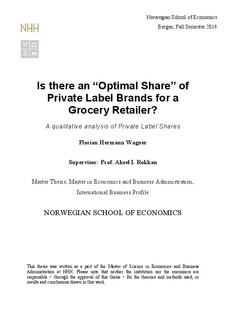| dc.description.abstract | The underlying master thesis was developed to answer the question “Is there an “optimal
share” of private label brands for a grocery retailer?” and “What factors determine the
variation of the private label brands share between different retailers?”. Due to the very
limited amount of literature geared towards private brand shares, a qualitative study, applying
a mixture of a deductive and an inductive approach was considered to be the most suitable to
provide an answer to the research questions. In particular, the research was initiated with a
literature review, followed by three interviews with retail experts from Germany and Portugal.
In recent times, the importance of private labels brands has been growing significantly. While
the UK has already realized the added value of private brands, other markets still need to
develop further. Therefore, it is of vital importance for the retailers to educate its customers
about the high quality standards of store brands in order to facilitate the companies’ success.
Due to the profitability of store brands as well as their attractiveness to customers, retailers
can considerably benefit from offering and selling private label brands.
The findings of the research have revealed that there is no “one-fits-all” optimum private label
share for a grocery retailer. In contrast to the prior expectations, it is not even possible to
determine an exact optimum for one particular retailer with a certain format. According to the
study at hand, the optimum should rather be regarded as a range, serving to provide guidance
to a retailer’s private brand strategy. What can be defined though, is an approximate
maximum that should not be exceeded, if customer loyalty and profitability are to be retained.
Regarding the sub-research question about potential factors impacting the variation of private
brand shares among retailers, the research disclosed that macroeconomics factors, competitor
actions, procurement possibilities, respectively suppliers’ availability and ability to deliver
quality-consistent products can have an essential impact on a PLB optimum. Additionally, the
retailer’s assortment, the price image one wants to convey, the margins a certain PLB might
entail, the targeted degree of customer loyalty, country-specific demand and the current ratio
of NBs versus PBs are of significant importance when defining a PLB optimum. Further,
store brands can serve as an income-protection during the times that NBs do not sell well at a
grocery store. Taking these aspects into consideration will simplify the determination of a
retailer’s PLB optimum as part of his PB strategy. However, all actions taken with regard to
store brands should always be aligned with the overall retail chain or corporate strategy. | nb_NO |
